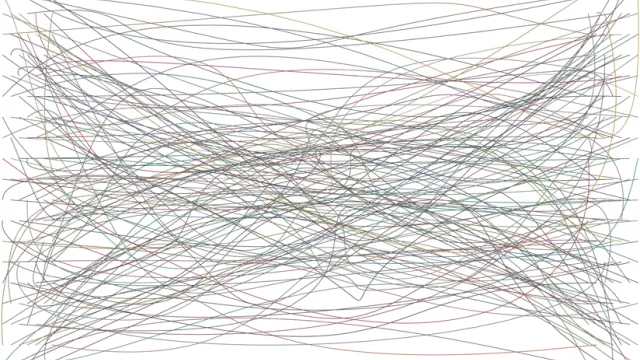These pieces show the range of variation that is possible within this simple system. Each panel contains a set of 24 randomly generated curves. Titles are the dates and times of generation.
Portfolio
Instantiations #3 (The Subjective)
Each of these panels contains a set of 4 images selected from a superset of 1000 randomly generated curves. This piece focuses on the interface between the machinic process of generation and the subjective process of selection. The grouplings formed on the basis of percieved similarity have little relation to the actual parameters which produce the work. The projective tendencies of the mind attribute characteristics like curliness, roundness, or even femininity, energy or wierdness to what are merely inert lines.
Instantiations #4 & #5 (The Tweens)
Because these curves have a kind of double ontology–they exist as figures, i.e. lines with a certain shape that can be drawn on screen or printed out on paper, and as a set of parameters within a complex parametric equation, i.e. a set of constitutive numbers, not unlike genetic material, from which they can be generated–they have specific manipulable properties. One of these is the ability to measure and interpolate the distance between any pair or set of figures.
Instantiations #6 (The Aggregates)
This series investigates the effects of accumulated random figures. As in the work of abstract expressionists like Pollack, the aggration of rendered gestures define a characteristic mood that adheres to the nature of the media rather than seeking to transcend it.
Instantiations #7 & #8 (The Animations)
In addition to the superimposition of images, there is a time-based strategy of accumulation of variation in sequence. These two pieces use this technique. They also embed the curve within other systematic relations.
Instantiations #9 (The Stack)
1000 numbered curves in a continuous tweened loop inhabit two reams of office paper. In the gallery, visitors were invited to take away pages from the stack and interupt the continuity of the tween.
Bezier
The project Bezier consists of experiments exploring the properties of the Bezier Curve – a workhorse of computer graphics. These elegant lines are the constituent elements of vector-based drawing and their mathematical basis finds its way into other aspects of visual display as well. For example, in motion graphics, the "ease-in" and "ease-out" functions used to create naturalistic movement can make use of bezier curves.
After Metronomic Irregularity
These works start from the example of Hesse's Metronomic Irregularity, translating the system first into language as a description of its system, and then into the performative language of software. The variability of paths between the regular spacing of the grid suggests a profusion of variation - the grid is exploded and parameterized relativized as a structuring mechanism. The possibilities for alternative organizing principles extends serially, pointing towards the infinite:
colorSpace
Color is imagined as a space. We see colors as distributed throughout a cube with black on one corner and white on the opposite corner. Red, green, blue, cyan, magenta, and yellow each have a corner.









